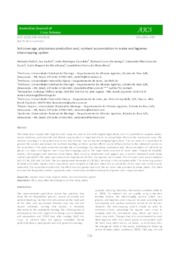Soil coverage, phytomass production and, nutrient accumulation in maize and legumes intercropping system.
Soil coverage, phytomass production and, nutrient accumulation in maize and legumes intercropping system.
Author(s): NOLLA, A.; JUCKSH, I.; CASTALDO, J. H.; ALVARENGA, R. C.; COSTA, L. M. da; DAMY, C. R. da S.; MOTA NETO, L. V. da
Summary: The maize intercropped with legume cover crops are used at low technological agriculture, due it?s potential to suppress weeds, recycle nutrients, and cover the soil. Weeds suppression it is important due to its competition effect on the commercial crops. The nutrient recycling it is important due to the low fertilizer use on low technological agriculture. The soil cover it is important to prevent the erosion and reduce the nutrients leaching. All those positive effects can be influenced due to the cultivated species on the consortium. This study aimed to evaluate the soil coverage, the phytomass production and, the accumulation of nutrients by plants in a maize and legume cover crops intercropping system. The experiment consisted of rustic maize ?Caiano de Sobrália? variety, intercropped with Brazilian velvet bean, black mucuna, lablab-bean and pigeon pea; a control treatment (sole maize culture) was added. The maize was sown on the experiment; 64 DAE, the legumes were sowed. The soil cover rates were evaluated at 0, 64, 84, 120, and 144 DAE. The corn grains were harvested at 120 DAE, resulting in the corn grain yields. The remaining portion of maize and entire legume cover crop plants were sampled at 144 DAE, when the accumulation of dry mass and nutrient were measured. The consortium system did not affect the corn grains yield and, the soil cover rate provided by maize plants. The black mucuna had the greatest weeds suppression and, nutrient accumulation among the legumes cover crops evaluated.
Publication year: 2019
Types of publication: Journal article
Unit: Embrapa Maize & Sorghum
Observation
Some of Embrapa's publications are published as ePub files. To read them, use or download one of the following free software options to your computer or mobile device. Android: Google Play Books; IOS: iBooks; Windows and Linux: Calibre.
Access other publications
Access the Agricultural Research Database (BDPA) to consult Embrapa's full library collection and records.
Visit Embrapa Bookstore to purchase books and other publications sold by Embrapa.

